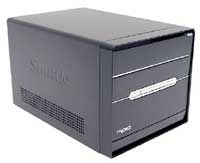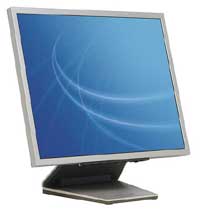Mid-Range SFF Gaming System
One area that we didn't address yet is the potential to go with a small form factor (SFF) system. This especially makes sense for those who attend LAN parties, not to mention the college students that lack space for a large system in their dorm rooms. Many people think that SFF systems are really expensive, but that's not necessarily true. All told, the cost of going with a SFF setup is about $50 more than going with a standard desktop system. There are drawbacks, but first, let's list our SFF configuration, again using an Athlon 64.
| Mid-Range SFF AMD Athlon 64 System |
| Hardware |
Recommended Component |
Price |
| Processor |
AMD Athlon 64 3500+ 512K 2.2 GHz (939) 90nm |
285 |
| Memory |
Mushkin Dual Pack 2x512 PC3200 2.5-3-3 |
159 |
| Video Card |
Albatron GeFORCE 6800 GT 256MB GDDR3 |
374 |
| Hard Drive |
Seagate 160GB SATA 7200RPM 8MB Model ST3160023AS |
93 |
| Optical Drive |
NEC DVD+/-RW Drive Model 3500A |
72 |
| SFF Case |
Shuttle XPC SN95G5 (AMD socket 939) |
299 |
| Display |
Samsung 172X 17 LCD |
429 |
| Speakers |
Logitech Z-640 5.1 |
52 |
| Keyboard |
Logitech Internet Keyboard |
17 |
| Mouse |
Microsoft IntelliMouse Optical |
24 |
| Bottom Line |
|
1804 |

Click to enlarge. |
The total price of our SFF configuration ends up being almost $300 more than the Mid-Range system, but there are reasons for this. We have included a 17" LCD with our SFF recommendation, which is the lion's share of the price increase. After all, what's the point of getting a space-saving, portable case if you're going to pair it with a bulky CRT? That adds an extra $200 to the price, so if you disagree and feel that CRTs and SFFs can peacefully coexist, you can put together a Mid-Range SFF system for $1600. As with the high-end setup, we strongly recommend that anyone looking for a quality LCD get a model that had a DVI-D interface. Unfortunately, one knock against the Samsung 172X is that it is an 18-bit display, which uses dithering/interpolation to "reproduce" 24-bit color. This doesn't matter too much in games, and the 12 ms response time convinces us to go with it anyway, but we're not entirely happy with the options in the 17" LCD segment. Besides the display, remember that a SFF case includes the motherboard and a custom heatsink for the CPU in addition to the case and power supply. So, the $300 cost of the Shuttle XPC takes the place of about $225 of desktop hardware - $250 if you want an aftermarket HSF for your system.

Click to enlarge. |
The one thing that you do sacrifice with a SFF is expansion options. Where most desktop cases can support three or four 5.25" drives, two external 3.5" bays, and three or more internal 3.5" hard drives, the Shuttle XPC that we have used is limited to one 5.25" drive and one 3.5" drive externally, along with one 3.5" internal mount for your hard drive. It is also limited to one AGP slot and one PCI slot, but with all of the included features, the lack of PCI slots is not likely to be an issue. RAM expansion options have been cut back to two DIMM sockets, so even with 1 GB DIMMs, you would max out at 2 GB of RAM. None of these issues are deal-breakers, however, and when paired with a 6800 or X800 graphics card, you have a lot of performance packed into a small, quiet chassis.
We have only included a SFF recommendation for a socket 939 Athlon system, but you could do the same with any other platform. Nearly every motherboard manufacturer has at least one SFF system available, and usually they have several. If you don't upgrade components frequently, SFF cases can be a convenient replacement of the standard "boring" home or office computer.












70 Comments
View All Comments
Arkali - Tuesday, November 23, 2004 - link
For Intel gaming you should have picked the new AOPEN socket 479 855GME motherboard and a Dothan processor.Glassmaster - Monday, November 22, 2004 - link
#30 Doesn't look like they are going to defend their PSU recommendations. I just want to know if they actually build and stress test these systems with the Generic PSUs to make sure their recommended systems really are reliable.Glassmaster.
Live - Monday, November 22, 2004 - link
I like the format of this guide. I think the guides in general has been a great addition to Anandtech.To bad PCI-e motherboards is not out yet. Since the sli previews are not out in force yet I'm still not 100% sure if its something you want on your motherboard for more upgradability but it sure looks like it is not. Too expensive both in terms of motherboard and the 2 cards. But for a gamer, investing in anything else then PCI-e seems like a bad move. Unless you like to buy second-hand. I bet a lot of AGP cards will soon be available on the market as the high end crowd switches to the latest.
mldeveloper - Monday, November 22, 2004 - link
i like the format of this guide, since i always jumped to the end to see the final price breakdown anyway.nurazlanshah - Monday, November 22, 2004 - link
is the a big difference in fps between 128mb and 256mb for a same graphic card?deathwalker - Monday, November 22, 2004 - link
Jarod...great writeup. Ignore all the sniping. It's a tough job doing a article like this and sometimes there just aren't any absolute rights and wrongs. Somepeople just like to pipe-off and be heard.AaronAxvig - Monday, November 22, 2004 - link
#15 I think if you really wanted maximum performance for a LOT of money, you would go with RAIDed SCSI. Very fast, no?Momental - Monday, November 22, 2004 - link
Fantastic article, Trog......I mean Jarrod. ;)I was considering going the SLI route with (2) two 6600GT's, but then realized that the performance is identical to that of one 6800GT. And who wants to take the chance of one of the GPU's defecating the bed? Additionally, the cost of the SLI-capable board ain't gonna be cheap. I will, however, wait for the VIA and nVidia PCI-e boards to become available before finally building a new system.
The only thing I might change from the mid-range system is to put in the lower latency RAM, such as the OCZ Plat Rev. 2 or the Ballistix. Pop on a good aftermarket HSF on the CPU and we're good to go!!
gilkman - Monday, November 22, 2004 - link
Very nice article. It's been a few years since my last homebuilt but with the new games it's def time to upgrade. I like the format of this article. It gives me a few more options and insight compared to the similar guides they have over at sharkeyextreme.comI am def looking at high end parts to put together and I was very interested in the Dell 20 inch widescreen LCD - Does anyone have any comments on using a widescreen LCD for games? The Dell widescreen has 16MS refresh and high resolutions, and I know that HL2 will support widescreen play, but what about other modern games like RTS's and RPG's? Is it safer to stick with a 4:3 screen?
SDA - Monday, November 22, 2004 - link
Looks good, but I object to using a cheap PSU for a lot of the systems. It's worth the small amount of extra money you pay to get a better PSU... a TON of the problems I've seen in DIY systems resulted from cheapo PSUs that couldn't deliver enough power or simply couldn't deliver clean enough power. Cheap PSU = false savings, IMHO. There are plenty of good PSUs out there for cheap (TTGI, CWT aka Antec).And yeah, sure, the budget rigs don't stress the PSU much. I still hold that you shouldn't go generic. Having looked inside a lot of generic PSUs, I can safely say that I wouldn't ever want to see one in ANY system I build.